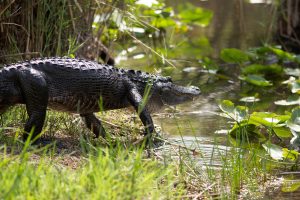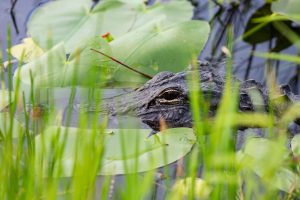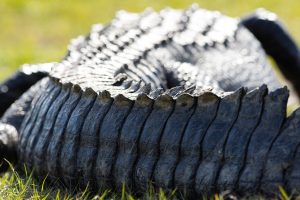
The American alligator, the official state reptile of Florida, which conjures both fear and admiration, is also being celebrated for its critical role in the ecosystem.
These majestic creatures, often misunderstood as aggressive man-eaters, are crucial indicators of environmental health, particularly when it comes to Everglades restoration.
“The reasons to fear alligators are unfounded, as they are not aggressive beasts, although as large predators they should be respected,” said Frank Mazzotti, professor of wildlife ecology at UF/IFAS Fort Lauderdale Research and Education Center (FLREC).
Once hunted to the point of extinction for their hides, alligators have made a remarkable comeback in part because of protection through the Endangered Species Act and ironically through commercialization for their hides and meat.
“Commercialization through hunting and ranching has not only protected alligators, but the habitats they live in as well, but what is most impressive and what most people don’t know is that alligators have recently assumed a new role of importance to humans — that of ecological indicator,” said Mazzotti, who also leads the UF Croc Docs.
The Croc Docs are a team of scientists who conduct long-term research on crocodilians, invasive reptiles and endangered species in South Florida and the Caribbean. Collaborating with various agencies, they address wildlife management needs, climate change and support Everglades restoration efforts.
Here, the team offers critical insights on the heels of National Alligator Day on May 29 and World Crocodile Day on June 17 as to why American alligators should perhaps be admired.

Q: How have alligators become a critical ally to humans?
A: Recently, alligators have taken on a new role as ecological indicators. At all life stages, they integrate biological impacts of environmental conditions, making them crucial for assessing the health of the Everglades ecosystem.
Research has shown that alligators link three key aspects of Everglades’ ecology:
- As top predators, alligators depend on the density of aquatic and semi-aquatic organisms, serving as a proxy for the status of many other species.
- By creating dry nests and wet trails and holes they provide habitats for various plants and animals that would otherwise not survive.
- They indicate necessity for natural patterns of freshwater flow. The distribution, abundance, and health of alligators in marshes and estuaries rely on freshwater flow, which is critical for ecosystem restoration in the Everglades.
Q: What is the goal of Everglades restoration, and how are alligators involved?
A: Everglades restoration aims to repair damage caused by drainage and development of the South Florida landscape. This complex and expensive effort is vital, as half of the Everglades has been lost to development, while the remaining area suffers from disturbed patterns of wet and dry and by invasion by nonnative species. There is a major question as to how well restoration will work, and alligators have been chosen as one of the species to be used to evaluate restoration progress. Healthy restoration should result in fatter alligators and increased alligator populations.
Q: How is the health of the alligator population monitored?

A: Monitoring involves counting and capturing alligators to assess their abundance and body condition. This process includes:
- Using airboats and motorboats to locate alligators at night when their eyes shine under light.
- Alligators are captured by hand, with tongs, nets, darts, or with self-locking wire loops. Unlike what you see on television, videos and social media, we secure the mouth of an alligator before bringing it on board the boat. This helps to ensure the safety of both alligators and the alligator catchers.
- Once on board, alligators are weighed and measured, marked using passive integrated transponder (PIT) tags or by removing scutes – the bony, raised plates often mistaken for scales – in the tail according to a prescribed sequence, and then released at the site of capture.
- Alligators are also counted.
Q: How is the collected data used?
A: Data on alligator counts and captures undergo statistical analysis to estimate their abundance and body condition. Correlations between these estimates and environmental conditions help understand trends over time. Comparing these trends with historical data and model predictions allows scientists to assess the impact of restoration efforts and differentiate them from non-restoration events like hurricanes or droughts.
Q: What are the current findings and future expectations for Everglades restoration?
A: Early restoration efforts show slight improvements in alligator populations, but there is still much work to be done. Alligators’ ability to serve as ecological indicators underscores their importance and reinforces why they should be revered, not feared.
Para accesar a este contenido en español, por favor utilice este enlace.
ABOUT UF/IFAS
The mission of the University of Florida Institute of Food and Agricultural Sciences (UF/IFAS) is to develop knowledge relevant to agricultural, human and natural resources and to make that knowledge available to sustain and enhance the quality of human life. With more than a dozen research facilities, 67 county Extension offices, and award-winning students and faculty in the UF College of Agricultural and Life Sciences, UF/IFAS brings science-based solutions to the state’s agricultural and natural resources industries, and all Florida residents.
 1
1
